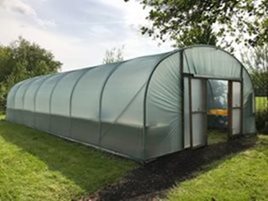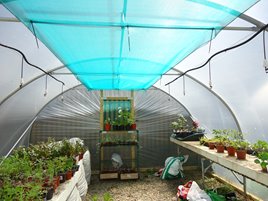Anyone who has stood inside a polytunnel on a sunny day will know how hot it can get – when it’s hot outside, the temperature inside a polytunnel will be considerably higher. Polytunnels are covered with a special type of polythene film that is designed to help you create a warmer environment in which you can grow a wide variety of crops. But while a certain amount of heat is desirable for many crops, too much heat is not always a good thing.
How hot should I let my polytunnel get?
 The ideal temperature for most polytunnel plants to thrive is 26-30 degrees Celsius, however it is not uncommon for polytunnel temperatures to soar well above this on hot, sunny days. Too much heat can slow down germination, cause problems with pests and diseases, result in fruit ripening issues, and also lead to problems with photosynthesis. Overheating can, ultimately, kill the plants you have tended and nurtured.
The ideal temperature for most polytunnel plants to thrive is 26-30 degrees Celsius, however it is not uncommon for polytunnel temperatures to soar well above this on hot, sunny days. Too much heat can slow down germination, cause problems with pests and diseases, result in fruit ripening issues, and also lead to problems with photosynthesis. Overheating can, ultimately, kill the plants you have tended and nurtured.
Polytunnel temperature control
So, how can you regulate your polytunnel temperature and help to maintain healthy plants?
You can provide shade and reduce the temperature by using a net polytunnel cover over the top of your polythene cover already in place. Our net polytunnel covers offer 47% shade and can also be used on their own to provide shade for your crops while still allowing full ventilation and rainwater to filter through.
 You can add shade and keep the polytunnel temperature down by tying shade net to the roof of your tunnel on the inside. Try using cable ties to fix the netting to the hoops, ridge, or crop bars.
You can add shade and keep the polytunnel temperature down by tying shade net to the roof of your tunnel on the inside. Try using cable ties to fix the netting to the hoops, ridge, or crop bars.
On hot days, damp paths inside the tunnel and mist overhead to help keep the atmosphere humid and discourage some pests.
Avoid overcrowding your plants at the planting stage – Overcrowding can lead to problems with air movement, which can make plants more prone to diseases.
Polytunnel ventilation
Ventilation is essential during the warmer months – Good ventilation can help you to avoid a lot of plant problems, such as wilting or curling leaves and moulds. Offer as much ventilation as you can by opening the polytunnel doors and side vents first thing in the morning, and leaving them open all day. Good ventilation will provide maximum, valuable air circulation throughout the tunnel and between the plants.
Maintaining good ventilation is important for photosynthesis – Photosynthesis is when plants absorb carbon dioxide from the air, combined with water and sunlight, to make their own food. Ensuring fresh air movement through your polytunnel and plants goes towards the survival of your plants.
Ventilation and circulation fans can be used inside a polytunnel when the temperatures soar.
When it is “too hot” inside your polytunnel, plan your regular watering schedule carefully…
And don’t forget the SPF and a drink for yourself!